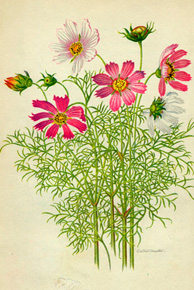Comely Cosmos
By Audrey Stallsmth

But the wonderful Mexican autumn, like a strange, inverted spring, was upon the land. The waste places bloomed with pink and white cosmos, the strange wild trees flowered in a ghostly way, forests of small sunflowers shone in the sun. . .
D. H. Lawrence, The Plumed Serpent
Like those other natives of Mexico, the dahlias, our comely cosmos flowers always seem to come late. Waiting until fall to bloom, they tend to get frosted just when they are finally hitting their stride. Fortunately, the frost is holding off this year, and both the dahlias and cosmos are yet blithely unaware of their impending fate. It sounds, from the quote above as if the latter, at least, also bloom in autumn in their native land.
They were probably “discovered” during one of Spain’s botanical forays into its New World possessions in the late 1700’s. Some seeds made it to England with the Marchioness of Bute, the wife of Britain’s ambassador to Spain, about that time. In a very roundabout trip, they didn’t become well known in most of North America until the late 1800’s, though Spanish priests probably grew them at their missions in what would later become the western U. S. prior to that time.
Also called the Mexican aster, the cosmos derives its name from the Greek kosmos (“ordered universe”), for its well-ordered petals. It is, in fact, related to the dahlia and some of its less well-known species grow from tubers as the dahlia does.
I fully intend to try the “chocolate” type, Cosmos atrosanguineus, one of these days when I can get my hands on a few tubers. Some people claim that the flower's scent is actually that of vanilla, but either of those sounds delicious to me! It grows only about 2 feet tall with 2-inch flowers, as compared to the more common species which can attain more than twice that height and size.
The two most commonly grown in gardens are bipinnatus (“twice pinnate or feather-like” in reference to the leaves), with colors from white and pink through maroon, and the more coarsely-foliaged sulphureus (“sulfurous" or "fiery”), with flaming colors like orange and yellow. Some other species, such as diversifolius (“different”), scabiosoides (“scabby”), and tenuifolius (“fine or delicate”) are mentioned in old books and periodicals such as an 1838 The Gardener’s Magazine, but never attained the popularity of bipinnatus, even though tenuifolius reportedly has even more finely cut leaves. Diversifolius and scabiosoides are both tuberous types.
Like morning glories, cosmos plants bloom best in dry and infertile soil. Where the ground is rich and wet, they make huge mounds of foliage but less flowers. A chief complaint against them when they were first introduced to England was that they didn’t bloom early enough to set seed. Here, they sometimes self-seed, though the self-seeded plants don’t seem to flower much earlier than those sown in late spring.
We won’t complain, however, as we have plenty of other flowers in mid-summer, but need all we can get this time of year. So if the cosmos prefer to scorn the dependably warm months to dance on the edge of destruction, we'll enjoy the show as long as we can!
Note: Cosmos image is from A Book of Garden Flowers by Margaret McKenny and Edith Johnston.








